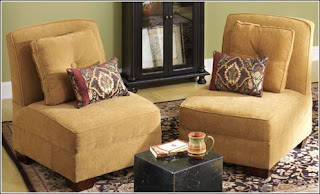
“Big Things Come In Small Packages” We’re all familiar with this quote, it’s normally associated with gifts not home decorating, but it should be.
A one or two bedroom house, apartment, condo or townhouse can be just as impressive and grand as something with fifteen bathrooms, Wow, imaging having to clean all those, I have enough trouble with two.
One interesting things I have found from past experience is that decorating a smaller place is actually easier, not to mention less expensive.
Whether your currently living in a small space or downsizing – that’s another one of those trendy “buzz” words, which simply means your moving into something smaller – planning how your going to decorate or redecorate is a good idea.
You may think because it’s smaller, having large pieces is out of the question. Not true, having oversized furniture is not going to make your rooms appear smaller, what it will do is give a warm inviting feeling.
Of course the layout and size of a room will determine how many pieces can comfortably go into it. After all, you may be looking for drama and comfort, but you still need to be able to maneuver around.
This also applies to accessories; it’s better to have a few large dramatic pieces as opposed to a lot of small items, which can tend to turn into clutter and dust collectors.
The exception to this would be with collections. But again you want to have places to showcase them like glass front hutches, cabinets, bookcases or shelves.
Another decorating challenge can be in warming up your new place. This normally can easily be achieved by adding color with paint.
Now that’s all fine and good unless you happen to be renting and your landlord say’s “Paint, oh no”. That’s OK, color can be added in a number of other ways.
Several examples: Window treatments - Furniture fabric -Accent pillows - Area rugs - Wall art - Plants & Flowers
Storage can be another issue in a smaller space, there just never seems to be enough.
If you’re buying new furniture or deciding on which pieces to bring from your current home, look for ones that can perform double duty.
For example: Instead of the standard coffee table, look for one with a flip top or shelves underneath. Cedar chests, blanket chests or trunks can also be substituted.
Place an armoire intended for the bedroom in the living room it’s the perfect storage place for remotes, magazines, extra bedding, kitchen linen or any of those pesky little things you just can’t seem to find a place for.
A small floor cabinet you might have used in a bathroom can become an end table. Most of these come with drawers, shelves or both.
Decorative stacking boxes or even old suitcases not only make for great storage, but they also become terrific accessories.
Plastic storage boxes come in a variety of sizes, colors and are inexpensive.
They can be stacked on shelves in a closet or cabinet, even into drawers. Clear smaller sizes are perfect storage for shoes, winter gloves, pictures or how about extension cords, nails, packages of hooks or hand tools.
Larger sizes can keep extra winter coats, blankets, odd season clothes or seasonal decorations neat and in one place.
Baskets and hampers are another option.
Kids rooms are always in need of extra places for all their treasures, plastic milk crates are perfect for them. They come in many bright brilliant colors. One suggestion, if you are planning on stacking the crates and have small children it would be beneficial to secure them to the wall.
Plastic shelving units, which can be found in most discount stores, are perfect for mounting on the backs of doors or on the wall in closets.
These come in especially handy in the kitchen for holding extra soda bottles, canned goods, paper towel etc.
Well, I think you’ve gotten the idea, look around and use your imagination; you will be surprised with what you can come up with.
Moving into and decorating a small space can be challenging, but with a little planning it can be just as beautiful as any large house. And in the end, size really doesn’t matter, if it’s filled with the people and things you love, then you have successfully created a home.



























